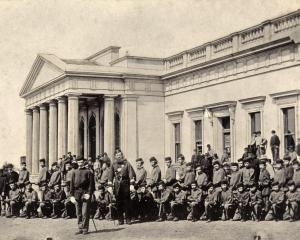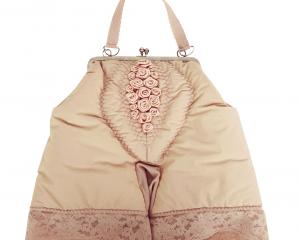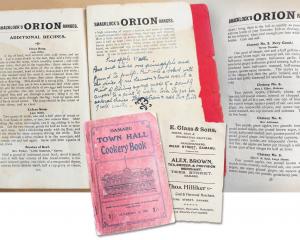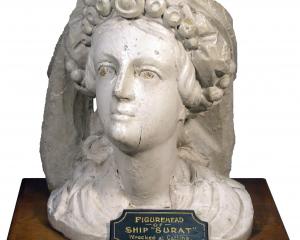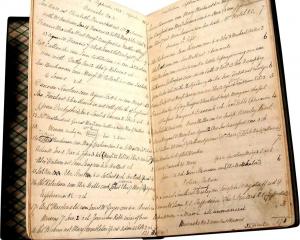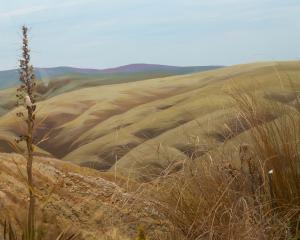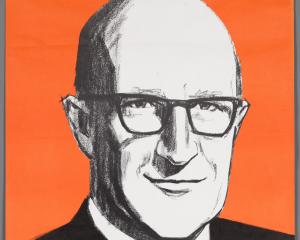In 1979, the Hocken received an outstanding gift from Colin and Anne McCahon of a 1.8m high kauri sculpture by Invercargill-born artist, ceramist and teacher Alison Duff (1914-2000).
Titled Manaia, and sculpted in the mid-1950s, the work first captured McCahon's imagination when it was displayed at the Auckland Art Gallery when he was keeper and deputy director from 1956-64, and Hong-Kong born Peter Tomory was director.
McCahon proposed purchasing Manaia for Auckland's collection, but was unable to persuade Tomory of its beauty and significance. In correspondence between McCahon and Hocken librarian Michael Hitchings in 1979, McCahon described it as "A most beautiful wood carving in kauri by Alison Duff ... a piece I've coveted for years" ... with a surface "so good it needs V.I.P. treatment". Offered for sale at Auckland's New Vision Gallery for $1900, McCahon utilised an aunt's inheritance to acquire Manaia with the intention of donating it to the Hocken, describing it "as a gift to Hocken ... from Anne and myself". "I hope you will love it as much as I do," wrote McCahon. "It's very tough ..."
Following a farewell ceremony and a polish with beeswax, Manaia was prepared for its journey to Dunedin by gallerist Kees Hos who wrapped it in black polythene, chenille bedspreads, carpet underfelt, a king-sized "Bissonia" square and blankets, thus bypassing McCahon's initial packing suggestion of re-purposing a cardboard coffin.
When Manaia arrived at the Otago Museum in September of 1979, at the time still home to the Hocken Library, which had been housed there since opening to the public in 1910, Hitchings and Curator Tim Garrity "humped it upstairs, with shortened breath" and unwrapped it. It made an immediate impression. Hitchings wrote to McCahon that it was the perfect piece of modern work of an inexpressible age, and a timely gift, as the Hocken was about move to a new building and Manaia was a fitting talisman to mark this significant transition.
Alison Duff considered Manaia one of her most important sculptures. She described it as an expression of her love of New Zealand's native bush, and of her grief and anger over the violence inflicted on the kauri and the ancient heritage they represented. Duff discovered the piece of kauri used to make Manaia deeply embedded in the mud of a creek in a gully near her home in Kiaora Rd, Birkdale, Auckland. She and her husband prised it out of the creek-bed over a six-month period, eventually dragging it up the hill and several hundred metres over farmland to their house using a neighbour's draught horse. Over a two-year period, she sculpted Manaia outdoors in the sunshine, on a rough grassy patch at the front of her house, surrounded by accumulating wood chips. Manaia took two years to complete. In her notes about the sculpture, Duff said she titled it Manaia, in the hope of "communicating with the source which had inspired the Maori artists of old" rather than imitating their work, and that her aim was to bring "an old kauri tree, in its own territory ... back to life".
Manaia is one of numerous works of art the McCahons donated to the Hocken during the late 1960s and '70s. Duff suggested to McCahon that Manaia be shown whenever his work was on display. And so it is, that this iconic sculpture, along with paintings by Colin McCahon and other New Zealand artists, is included in the exhibition "A Garden of Earthly Delights". Bringing together a diverse selection of items from numerous special collections at the University of Otago, this exhibition aims to celebrate 150 years of teaching, research, collecting and curiosity at the university.
See it
- Closing Sunday, August 11, "A Garden of Earthly Delights" can be viewed at the Hocken Library, 90 Anzac Ave, Monday to Saturday from 10am to 5pm.
Robyn Notman is head curator, pictorial collections, at Hocken Collections.





